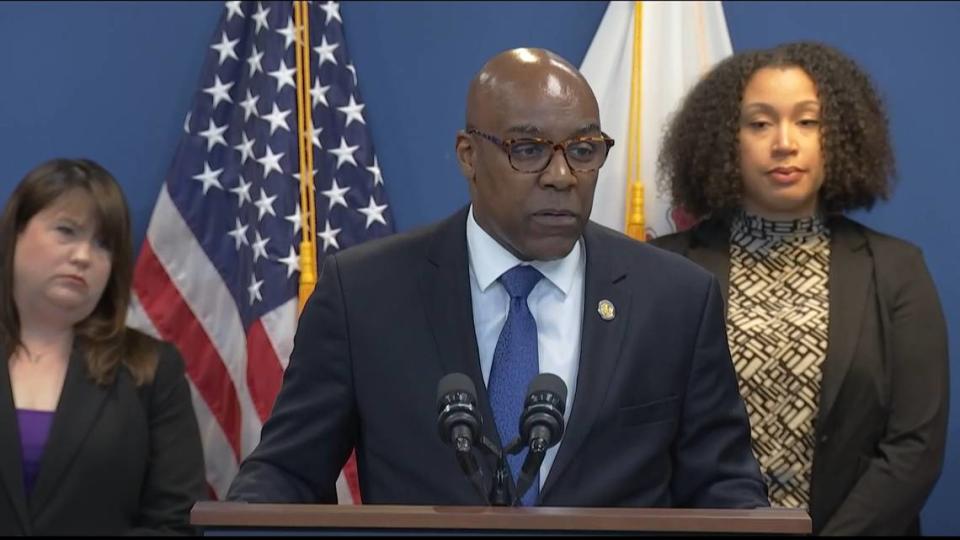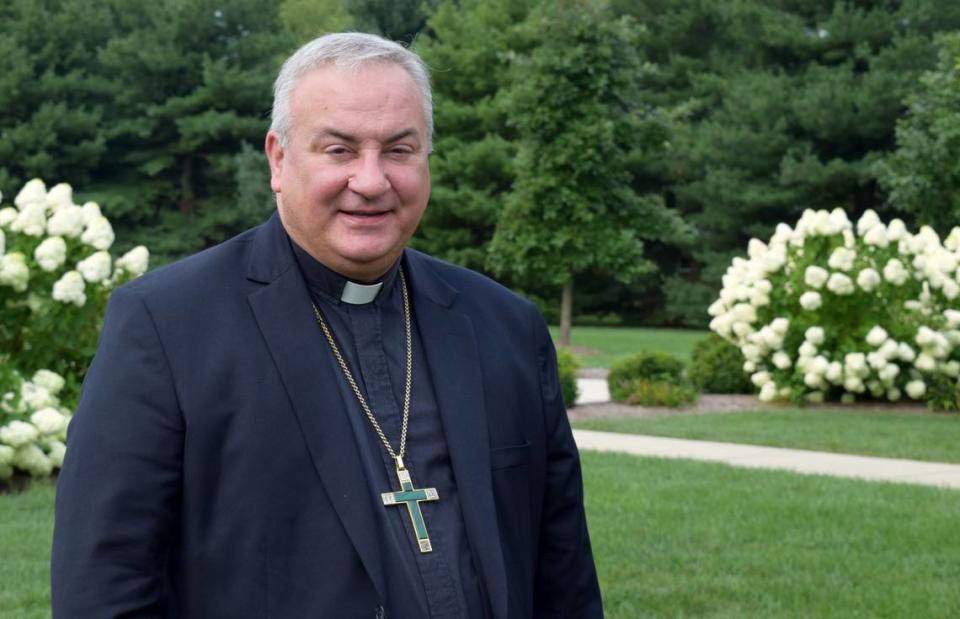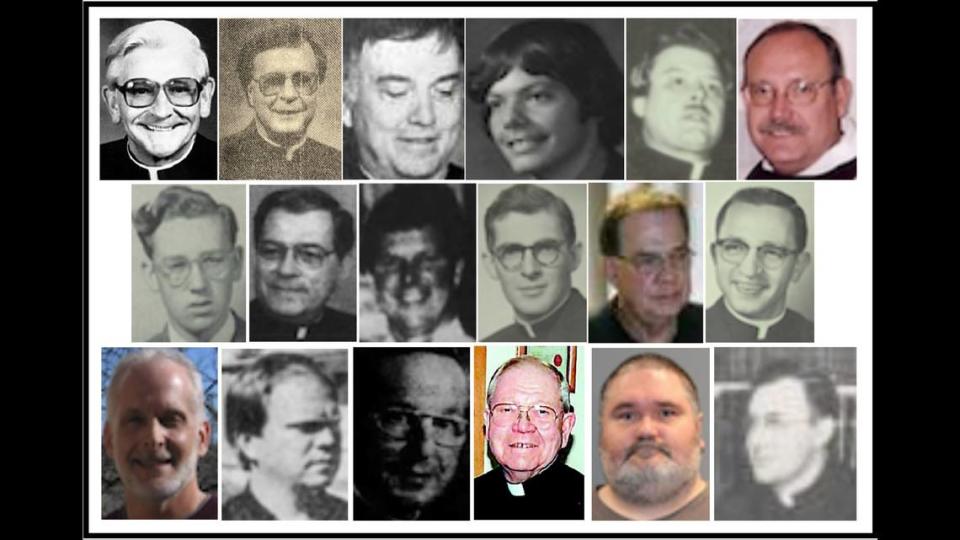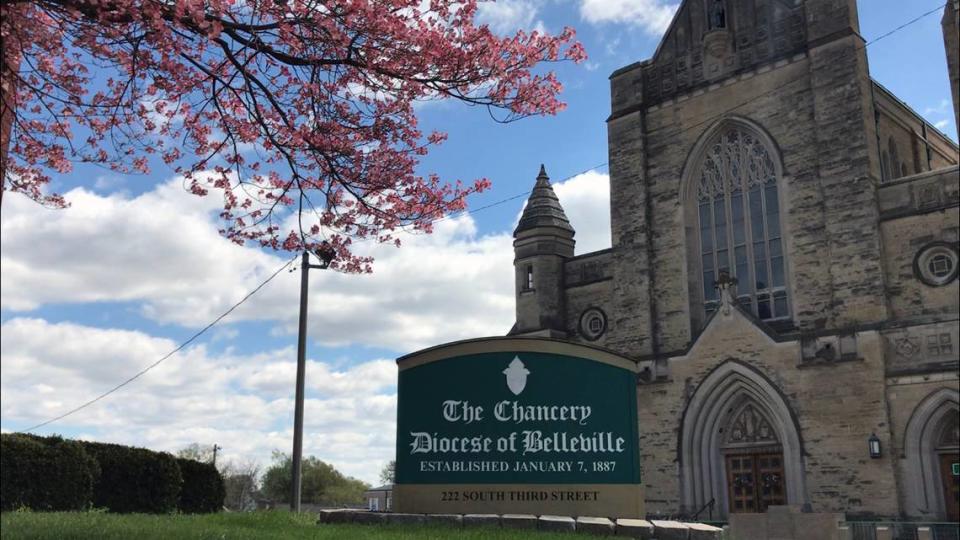What new information does report reveal about Belleville Diocese child-sex-abuse cases?
The public has been hearing about child sex abuse in the Catholic Diocese of Belleville since the early 1990s, when church officials acknowledged that some of its priests had been “credibly accused.”
A report released last week by Illinois Attorney General Kwame Raoul’s office is peeling back a few more layers.
The report examines problems in all six Catholic dioceses in the state. The section on the Belleville Diocese contains disturbing narratives on six former clergy, describing sexual encounters between children and priests in graphic detail, as well as cover-ups by past church leaders.
“Diocese leadership, including multiple bishops, knew of, and participated in, the transfer of a known child sex abuser from parish to parish, over a course of decades,” according to a history on the Rev. Raymond Kownacki.
The late priest was removed from ministry in 1995, nearly 23 years after the first allegation against him, the report states.
Beyond the six narratives, the report lists 43 clergy with “substantiated” allegations of child sex abuse who served in the 28 counties in southern Illinois covered by the Belleville Diocese, including basic facts on each case.
Much of the information already had been reported by the BND, other media organizations, victims-rights groups and the diocese itself. Here’s a look at what’s new.

1. The report provides more details about when and where alleged abuses occurred.
The Belleville Diocese published its first public list of credibly-accused clergy in 2018, providing the names of 16 diocesan priests and one deacon. Most had been removed from ministry in the 1990s.
The list was later expanded to include the names of four more diocesan clergy, as well as their parish assignments and dates of their ordinations, removals and, if applicable, deaths.
The Missouri chapter of the Survivors Network of Those Abused by Priests (SNAP) has frequently demanded more information to help victims determine when and where they may have been abused as children.
The attorney general’s report provides additional details, such as number of known victims for each case.
The diocesan priest with the largest number of alleged victims is the late Rev. Robert Vonnahmen, who was removed from ministry in 1993 after serving 37 years in the diocese. He also was founding director of Camp Ondessonk, a summer camp for Catholic children, from 1958 to 1984.
The report concludes that Vonnahmen sexually abused at least 23 children over three decades.
Internal records that church leaders allowed state investigators to review showed that the diocese first received notice of allegations against Vonnahmen in 1992, according to the narrative on his case.
“But diocesan records also reveal allegations that Vonnahmen’s fellow priests implored the diocese’s bishop to investigate him for child sex abuse as early as 1968 or 1969,” it states. “...The bishop failed to act.”
The report provides dates for when records show that the diocese first received notices of allegations against other priests as well.
The first allegation came in 1972 against Kownacki, who sexually abused at least nine children, according to the report. He was removed in 1995 after 35 years of ministry and laicized in 2013.
Also in the report are dates and locations where abuse allegedly occurred, dates when names of credibly-accused clergy were placed on public lists and which dioceses and/or religious orders took that action.

2. We now know something about accused clergy from other religious orders.
The 43 men listed in the Belleville Diocese’s section of the attorney general’s report include not only the 21 diocesan clergy, but also 22 from religious orders or other dioceses who temporarily served in parishes, schools, hospitals and programs in southern Illinois.
The Belleville Diocese’s public list of credibly-accused clergy includes only names of those in the second group. It doesn’t provide their assignments or ordination, removal or death dates.
This has led to criticism by the SNAP organization, which argues that a priest’s roots shouldn’t matter in the effort to help child-sex-abuse victims get the information they need.
Monsignor John Myler, spokesman for the diocese, said last week that church leaders have taken the position that it’s more appropriate for other religious orders or dioceses to release details on their own clergy.
The state report provides many of the same basic facts on the 22 non-diocesan clergy who served in southern Illinois as it does on the 21 diocesan clergy. That includes number of known victims in each case, for a total of 126.
The report also identifies religious orders or other dioceses for the 22 non-diocesan clergy. Ten were part of the Oblates of Mary Immaculate, the order that operates the National Shrine of Our Lady of the Snows in Belleville, and five were Marianists (Society of Mary).
One accused clergyman also came from each of the following: the Jesuits, Salesians Don Bosco, Trinitarians, Secular Franciscans and dioceses in Joliet, Dallas, Texas, and Bridgeport, Connecticut.
In some cases, the alleged sexual abuse occurred in southern Illinois, a different location or both. In other cases, locations are listed as “unknown.”

3. Illinois’ attorney general credits the diocese for improving under recent bishops.
The attorney general’s report seems to indicate that the decades-long gap between the first child-sex-abuse allegation against Kownacki and his removal from ministry was the exception rather than the rule in the Belleville Diocese.
Allegations against 12 of the 21 accused diocesan clergy first came to the attention of church leaders in the 1990s, including seven in 1993, based on the internal records that state investigators reviewed.
The BND published the first of more than 200 stories on the church scandal on Feb. 20, 1993.
Of those 12 clergy accused in the 1990s, 10 were removed from ministry the same year or the year after church leaders received first notices of allegations, based on the records.
As for the four diocesan clergy removed from ministry in later years (2002, 2018 and 2020), they were removed the same years that church leaders received first notices of allegations, based on the records.
The report acknowledges improvements in the diocese, which has been led in recent decades by former Bishop Wilton Gregory (now cardinal and archbishop of Washington, D.C.), former Bishop Edward Braxton and current Bishop Michael McGovern, who was installed in 2020.
“The Diocese of Belleville has made strides forward in child protection procedures, investigating child sex abuse allegations, and publicly disclosing clerics who ministered within the diocese and are substantiated child sex abusers,” it states in the Belleville section.
“The Attorney General takes note of those strides, and discusses them elsewhere in this report. But here, the emphasis is on the diocese’s history of child sex abuse cover-up — a history Bishop McGovern seems determined not to repeat.”
The diocese formed a lay-majority review board in the 1990s to investigate child-sex-abuse allegations against clergy and make recommendations to the bishop on appropriate action.
McGovern told the BND earlier this year that church policy includes notifying law enforcement and the Department of Children and Family Services of allegations and asking accused clergy to stay away from assigned parishes while they’re under review.
In a statement responding to release of the state report last week, McGovern apologized for the diocese’s “inadequate” response to child-sex-abuse allegations in the past.
“The Diocese is fully committed to continue protecting the safety of all children entrusted to its care and doing everything it can to prevent them from suffering any form of abuse,” he wrote.

4. There’s a slight discrepancy on how many accused priests served in southern Illinois.
While the attorney general’s report names 43 accused clergy who have served in southern Illinois, the Belleville Diocese’s public list includes only 42. The Rev. Frederick A. Lenczycki isn’t on it.
The story behind the discrepancy illustrates the tug-of-war between SNAP, which wants more pedophile priests to be identified, and church leaders, who have a process in place for verification.
“We have to (follow the process),” said Myler, the diocese’s spokesman. “It’s the only just thing to do. It doesn’t happen quickly, but it happens surely.”
Lenczycki was a priest in the Joliet Diocese for 30 years. His history of child sex abuse dates back to the 1980s. He pleaded guilty to aggravated sexual assault in 2004 in Illinois and sodomy in 2019 in Missouri.
Lenczycki was committed to a state institution for treatment in 2008 after a jury determined him to be “sexually violent.” Now 78, he’s at Farmington Correctional Center, serving his second prison sentence.
SNAP demanded in 2018 that the Belleville Diocese add Lenczycki to its public list of credibly-accused clergy.
“A new abuse report released last month in California showed that a serial abusive priest (Lenczycki), who molested an estimated 31 boys in three states over 25 years, worked at the Pastoral Center in Belleville in the 1990s,” according to a SNAP press release.
At the time, the diocese was only listing its own clergy who had been removed from ministry, not those from other religious orders or dioceses with temporary assignments in southern Illinois. That policy has since changed.
Lenczycki’s name came up again recently, when investigators from the attorney general’s office asked about him while doing research for the state report, according to Myler.
“We have no record of him living or ministering in the Belleville Diocese,” Myler said. “... “Our attorney’s talked to priests, office workers, people who have been here for 30-plus years. No one has any recollection of this man.”
Myler said someone found a reference to Lenczycki serving as a chaplain at “Deaconess Hospital in Belleville,” but he noted that the hospital is actually in St. Louis.
Lenczycki’s file on Bishopaccountability.org includes a transcript of a DuPage County Circuit Court hearing in 2004, when the priest pleaded guilty to sexually abusing three boys. The prosecutor listed 14 assignments for him, including the Pastoral Center in Belleville from August 1991 to July 1992.
The attorney general’s office included Lenczycki as an accused priest in the Belleville diocese section of its report. Spokeswomen Annie Thompson said investigators got the information from the DuPage County court case.
“The transcript indicates that neither Lenczycki nor his attorney objected to or clarified the listed assignments,” she wrote in an email, adding that a Catholic directory also stated that he was assigned outside of the Joliet Diocese from 1991 to 1992.
Myler said it hasn’t been the practice of the Belleville Diocese to place names on its public list of credibly-accused clergy if it has no record of people serving in southern Illinois.
“If we somehow get information that proved (Lenczycki) lived here or worked here, we would go through the steps, and he would be listed,” Myler said. “But right now, we have absolutely nothing on this man.”

